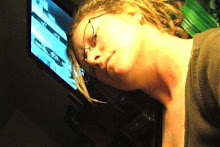1. While Brakhage’s Reflections on Black is a trance film, why does Sitney argue that it anticipates the lyrical film?
In reflections on black, Brakhage begins to explore the idea of the camera being the eyes of the filmmaker. Not so much as in a dream like in trance film but how the filmmaker perceives the world. In Reflections on Black, the film imagines how a blind man “sees” the world. Brakhage uses the film itself to convey the blind mans “vision”, by altering exposure, intercutting and scratching on the film itself.
2. What are the key characteristics of the lyrical film (the first example of which was Anticipation of the Night).
The filmmaker is the protagonist of the film. Movement instead of a hero fills the screen, emulates a person looking. Superimposition, multiple perspectives and acknowledging the screen and the film media itself is characteristic of the lyrical film.
3. Which filmmaker was highly influential on Brakhage’s move to lyrical film in terms of film style, and why?
Joseph Cornell, wanted Brakhage to film the Third Ave. El before it was destroyed. Here he had to use rhythmic editing and camera movement to convey the experience of vision with no actor or dramatic structure.
4. What does Sitney mean by "hard" and "soft" montage? What examples of each does he give from Anticipation of the Night? {Tricky question; read the entire passage very carefully.]
Brakhage uses “hard” montage like the opening of Anticipation of the Night, colliding night and day shots, inversion and repetition to counterpoint the “soft” montage of images fusing shadows and blending scenes like the shadow of the rose in the bowl merging with the shadow of the protaganist.
5. What are the characteristics of vision according to Brakhage’s revival of the Romantic dialectics of sight and imagination? [I’m not asking here about film style, I’m asking about Brakhage’s views about vision.]
Vision according to Brakhage, is limited by our perception and language of what we have been taught to see. Most of what we see is ignored because our brain filters out what we perceive as unimportant information. By altering the lens, speed and film stock Brakhage attempt to show what the eye really sees remove from what we have been taught to see.
Sitney, “Major Mythopoeia”
6. Why does Sitney argue, “It was Brakhage, of all the major American avant-garde filmmakers, who first embraced the formal directives and verbal aesthetics of Abstract Expressionism.”
By scratching and painting on the film itself along with flying cameras and fast cutting Brakhage brought attention to the media itself staying away from structure and myth and focusing on the film itself as a form of expression like the artist that explored the media of paint and canvas instead of representations.
7. What archetypes are significant motifs in Dog Star Man, and which writers in what movement are associated with these four states of existence?
Birth of consciousness, innocence – Ezra Pound, Noh drama
Experience, cycle of seasons, sexual disillusionment – William Blake, Northrope Frye
Ulro, hell of rationalization, self-absorption, domination of nature- Robert Kelly
Eden, redemption – Mallarme and Stevens
Sitney, "The Potted Psalm"
[This is an addition to the syllabus. After reading the introductory paragraphs, focus on the discussions of The Cage and Entr'acte (p. 47-54 and The Lead Shoes (p. 68-70).]
8. According to Sitney, what stylistic techniques are used to mark perspective and subjectivity in The Cage, and why is this an important development in the American avant-garde film?
He used all camera times, slow, fast, normal, reverse, superimposition and stop motion, distorted lens. These radical techniques used as metaphors for the liberated eye, this paves the way for future refinements in cinematic perspective
9. For Sitney, what are the key similarities and differences between Entr'acte and The Cage?
Similarities include use of camera tricks and the chase sequence. The films differ since Entr'acte was more focused on comedy. The Cage had a more aesthetic focus
10. How does Peterson synthesize the seemingly incongruent suggestions of his Workshop 20 students into The Lead Shoes?
The intertwining of ballads, synthesis of ideas
11. Compare your response to The Lead Shoes with the descriptions by Sitney and Parker Tyler.
Unlike Parker and Sitney I did not about the combining of the ballads, but I had a sense of a story, mainly because of the soundtrack.

#6: Not quite abandoning myth, because Dog Star Man will be mythopoeic. But the analogy between action painting and Brakhage's techniques is right.
ReplyDelete